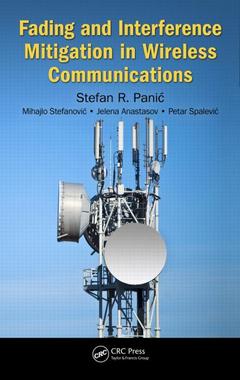Description
Fading and Interference Mitigation in Wireless Communications
Authors: Panic Stefan, Stefanovic Mihajlo, Anastasov Jelena, Spalevic Petar
Language: English
Subjects for Fading and Interference Mitigation in Wireless...:
Keywords
wireless communications; multipath fading and shadowing; co-channel interference; space diversity reception; Cochannel Interference; modulation techniques; CCI; Fading Channels; Multipath Fading; Diversity Branches; Average SNR; Confluent Hypergeometric Function; Equal Gain Combining; LCR; Maximal Ratio Combining; Average Signal Power; Outage Probability; Lower Incomplete Gamma Function; Output SNR; AWGN Channel; Unit Bandwidth; Instantaneous SNR; Interference Limited System; Adaptive Transmission; Constant Correlation Model; Channel Inversion; Maximal Doppler Shift Frequency; SNR Ratio; CSI
172.36 €
In Print (Delivery period: 15 days).
Add to cartPublication date: 12-2013
Support: Print on demand
94.88 €
In Print (Delivery period: 14 days).
Add to cartPublication date: 10-2017
· 15.6x23.4 cm · Paperback
Description
/li>Contents
/li>Readership
/li>Biography
/li>
The rapid advancement of various wireless communication system services has created the need to analyze the possibility of their performance improvement. Introducing the basic principles of digital communications performance analysis and its mathematical formalization, Fading and Interference Mitigation in Wireless Communications will help you stay up to date with recent developments in the performance analysis of space diversity reception over fading channels in the presence of cochannel interference.
The bookpresents a unified method for computing the performance of digital communication systems characterized by a variety of modulation and detection types and channel models. Explaining the necessary concepts of digital communication system design, the book guides you step by step through the basics of performance analysis of digital communication receivers.
Supplying you with the tools to perform an accurate performance evaluation of the proposed communication scenarios, the book includes coverage of multichannel reception in various fading environments, influence of cochannel interference, and macrodiversity reception when channels are simultaneously affected by various types of fading and shadowing. It also includes many numerical illustrations of applications that correspond to practical systems.
The book presents a large collection of system performance curves to help researchers and system designers perform their own tradeoff studies. The presented collection of system performances will help you perform trade-off studies among the various communication type/drawback combinations in order to determine the optimal choice considering the available constraints.
The concepts covered in this book can be useful across a range of applications, including wireless, satellite, terrestrial, and maritime communications.
Introduction. Modeling of Fading Channels. Correlative Fading Models. Performances of Digital Receivers. Single-Channel Receiver over Fading Channels in the Presence of CCI. Multichannel Receiver over Fading Channels in the Presence of CCI. Macrodiversity Reception over Fading Channels in the Presence of Shadowing. Evaluations of Channel Capacity under Various Adaptation Policies and Diversity Techniques.
Stefan R. Panić received his MSc and PhD in electrical engineering from the Faculty of Electronic Engineering, Niš, Serbia, in 2007 and 2010, respectively. His research interests in the field of mobile and multichannel communications include statistical characterization and modeling of fading channels, performance analysis of diversity combining techniques, and outage analysis of multiuser wireless systems subject to interference. In the field of digital communications, his current research interests include information theory, source, and channel coding, and signal processing. He has published more than 40 SCI indexed papers. Currently, he works as docent in the Department of Informatics, Faculty of Natural Science and Mathematics, University of Priština, Serbia.
Mihajlo Stefanović was born in Niš, Serbia in 1947. He received B.Sc., M.Sc. and Ph.D. degrees in electrical engineering from the Faculty of Electronic Engineering (Department of Telecommunications), University of Niš, Serbia, in 1971, 1976 and 1979, respectively. His primary research interests are statistical communication theory, optical and satellite communications. He has written or co-authored a great number of journal publications.
Jelena Anastasov was born in Vranje, Serbia in 1982. She received her M.Sc. degree in Electrical Engineering from the Faculty of Electronic Engineering, Niš, Serbia, in 2006 as the best graduated student of the generation 2001/2002. She is currently pursuing her PhD degree in the Telecommunications Department, as a Research Assistant at the Faculty of Electronic Engineering, Niš, Serbia. Her research interests are statistical communication theory, optical and satellite communications, and optimal receiver design. She has published several journal publications on the above subject.
Petar Spalević was born in Kraljevo, Serbia in 1973. He received his B.Sc.and M.Sc. degrees in electrical engine




